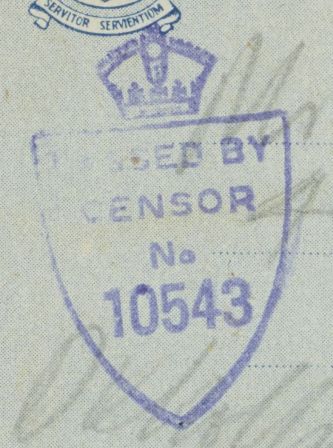Flesh wounds : David Holbrook and D-Day
David Holbrook, later well-known as a writer, educationist and controversialist, landed in Normandy as a twenty-one year old tank commander on D-Day, 6 June 1944. He recounted his experiences in his autobiographical 1966 novel Flesh wounds, which has been described as ‘one of the few war novels that is conceived on the same plane as Wilfred Owen’s war poems’. ‘Flesh wounds: David Holbrook and D-Day’, a new exhibition in the Library’s Entrance Hall, marks the 70th anniversary of the Allied invasion of Europe and draws on Holbrook’s literary archive, generously donated to the Library by his family in 2012.
Holbrook served in the East Riding Yeomanry, an armoured regiment which operated American-designed Sherman tanks on D-Day. The exhibition includes a letter, written on a NAAFI (Navy Army & Air Force Institutes) letter form, sent by Holbrook from the Normandy beachhead to his parents in Norwich, in which he describes the Nazis as ‘brutal overgrown boyscouts’, and says the Germans ‘fight cleverly & dirtily – chiefly in the evenings.’ An amended version of the letter was printed in Flesh wounds.
Another letter on show was written in Leeds during Holbrook’s convalescence from an infected wound sustained during the shelling of his unit’s headquarters on 21 June, and shows an early formulation in prose of experiences that were later to form the basis of episodes in Flesh wounds. The display also includes sheets from an autograph draft of the ‘D+2’ chapter of the novel, recounting events in Normandy on 8 June 1944; this contains a lengthy (and highly uncomplimentary) account of the British Sten gun, and a comparison of it with its German equivalents and with weapons of earlier eras, which was largely discarded in the published version of the novel. Copies of some of the many printings of Flesh wounds, in hardback and paperback, are also included.
Holbrook returned to the sites of the Normandy battlefields in 1994 for the fiftieth anniversary of the campaign, and provided an account of his visit for members of his old regiment: a typescript of this short text concludes the exhibition, and gives an account of the wording on the gravestones of former comrades killed by the shelling in which Holbrook was himself wounded: ‘On the grave of Major Tony Fitzwilliam-Hyde [sic] it says, “The people that do know their God shall be strong and do exploits”. On that of Sergeant L Harness, “Whosoever reads his name salutes a mighty company who died that we might be free”. On the grave of Cpl. A. Emsley, “Proud and treasured memories of a darling husband and daddy. Age 23.”’
The exhibition will run in the Entrance Hall until Saturday 21 June. A complementary Virtual Exhibition, with additional material not included in the Entrance Hall cases, is accessible on the Library’s exhibitions webpage, and can be viewed here.

